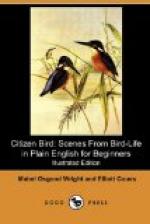“Everything in the daily life of a bird is interesting. You will find that every bird has its regular times for bathing, pluming, eating, sleeping, working, and playing, all in its own ways, just as you yourselves have. And everything he does is done cheerfully and promptly.
“I know that you think this a very long sermon, and that you would rather see a bird than be told how to see it. Only one word more. I am going to give you, as we go along, a few facts about the color and size of each bird, that you may write in your books; so that if you forget whether this bird or that one was striped or spotted you can look at your ‘bird table’ (not multiplication table) and see which it was. Now we will begin with our dear Bluebird.”
CHAPTER IX
A SILVER-TONGUED FAMILY
THE BLUEBIRD
“It will be difficult for you to mistake this little blue-coal for any other bird. He is ‘true blue,’ which is as rare a color among birds its it is among flowers. He is the banner-bearer of Birdland also, and loyally floats the tricolor from our trees and telegraph wires; for, besides being blue, is he not also red and white?”
[Illustration: Bluebird.]
“To be sure, his breast is perhaps more brown than red, but when the spring sun shines on his new feathers, as he flits to and fro, it is quite bright enough to be called red. All sorts and conditions of people love and respect the Bluebird; all welcome him to their gardens and orchards. The Grossest old farmer, with his back bent double by rheumatism, contrives to bore some auger holes in an old box and fasten it on the side of the barn, or set it up on the pole of his hayrick; while the thrifty villager provides a beautiful home for his blue-backed pets—a real summer hotel, mounted on a tall post above a flower-bed, with gables and little windows under the eaves.
“Why does this bird receive so much attention? There are many others with gayer plumage and more brilliant songs. It is because the Bluebird is gentle, useful, brave, and faithful under adversity, while he and the Robin are the first two birds that children know by name. We must live in a very cold, windswept part of the country not to have some of these birds with us from March until Thanksgiving day, and then, when a week has passed and we have not seen a single one, we say winter has come in earnest. When weeks go by and our eyes grow tired of the glare of the snow, or our hearts discouraged at the sight of bare lifeless trees and stretches of brown meadow—suddenly, some morning, we hear a few liquid notes from an old tree in a sunny spot. All eagerness, we go out to see if our ears have deceived us. No, it is a Bluebird! He is peeping into an old Woodpecker’s hole and acting as if he had serious thoughts of going to housekeeping there, and did not intend waiting to move in until May-day either. When you see him you may know that, though there is still ice on the water-trough and on the little streams, spring is only around the corner, waiting for her friend, the sun, to give her a little warmer invitation to join him in their old, old play of turning the sluggish sleeping brown earth into a wonderful green garden again.




